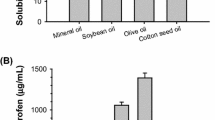Abstract
Saturated solubility and reaction rate constants for the decomposition of benzoyl peroxide in solution and suspension were determined for use in formulation development. The solvents studied included ethanol, propylene glycol, and cosolvent mixtures of PEG 400 and water. The solubility of benzoyl peroxide was inversely related to the solvent polarity, with greater solubility occurring with semipolar solvents. The stability of benzoyl peroxide in solution was dependent on the solvent, concentration of benzoyl peroxide, and temperature. The compound was least stable in PEG 400. Stability was improved when water was added to PEG 400. Similar solvent effects were observed in suspension. In benzoyl peroxide suspensions of PEG 400 and PEG 400/water blends, benzoyl peroxide stability was dependent on solubility, with improved stability occurring in blends where the benzoyl peroxide was least soluble. Thus, solution formulations of benzoyl peroxide in pharmaceutically acceptable solvents are unlikely to show good stability; however, suspension formulations should be reasonably stable if the vehicle is selected to provide low benzoyl peroxide solubility.
Similar content being viewed by others
REFERENCES
J. A. Billow. Acne products. In E. G. Feldman and D. E. Davidson (eds.), Handbook of Nonprescription Drugs, 8th ed., APhA, Washington, DC, 1986, pp. 583–597.
C. Walling. Free Radicals in Solution, John Wiley and Sons, New York, 1957.
W. E. Cass. Products of the reaction of benzoyl peroxide with certain ethers. J. Am. Chem. Soc. 69:500–503 (1947).
P. D. Bartlett and K. Nozaki. The decomposition of benzoyl peroxide in solvents. II. Ethers, alcohols, phenols and amines. J. Am. Chem. Soc. 69:2299–2306 (1947).
K. Nozaki and P. D. Bartlett. The kinetics of decomposition of benzoyl peroxide in solvents. J. Am. Chem. Soc. 68:1686–1692 (1946).
W. E. Cass. Kinetics of the decomposition of benzoyl peroxide in various solvents. J. Am. Chem. Soc. 68:1976–1980 (1946).
J. Court, S. Vidal, and J. M. Bonnier. Decomposition of benzoyl peroxide in 4-carbomethoxy pyridine and in mixtures of 4-carbomethoxy pyridine and benzene. Tetrahedron 44:6623–6631 (1988).
F. A. Carey and R. J. Sundberg. Advanced Organic Chemistry: Part A. Structure and Mechanisms, Plenum Press, New York, 1977.
J. N. Bollinger, D. Lewis, and V. M. Mendez. Benzoyl peroxide stability in pharmaceutical gel preparations. J. Pharm. Sci. 66:718–722 (1977).
W. G. Gorman and G. D. Hall. Dielectric constant correlations with solubility and solubility parameters. J. Pharm. Sci. 53:1017–1020(1964).
V. D. Gupta. The effects of some formulation adjuncts on the stability of benzoyl peroxide. J. Pharm. Sci. 71:585–587 (1982).
K. A. Connors, G. L. Amidon, and V. J. Stella. Chemical Stability of Pharmaceuticals: A Handbook for Pharmacists, John Wiley and Sons, New York, 1986.
Author information
Authors and Affiliations
Rights and permissions
About this article
Cite this article
Chellquist, E.M., Gorman, W.G. Benzoyl Peroxide Solubility and Stability in Hydric Solvents. Pharm Res 9, 1341–1346 (1992). https://doi.org/10.1023/A:1015873805080
Issue Date:
DOI: https://doi.org/10.1023/A:1015873805080




